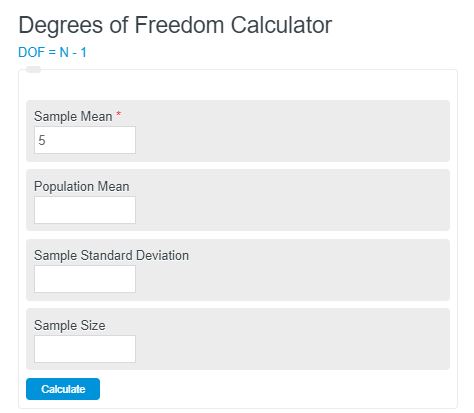Enter the total number of samples of a data set into the calculator. The calculator will display the total number of degrees of freedom. The calculator will also display the t-statistic if the additional information needed is displayed.
- Standard Normal Distribution Calculator
- T Statistic Calculator
- Round to the Nearest Tenth Calculator
- Conditional Probability Calculator
- MSR (Mean Square of Regression) Calculator
This calculator can also calculate the sample size given the number of degrees of freedom.
Degree of Freedom Formula
The following formula is used to calculate the degrees of freedom.
DOF = N - 1
- Where DOF is the degrees of freedom
- N is the sample size
To calculate the number of degrees of freedom, subtract a value of 1 from the sample size.
Degrees of Freedom Definition
Degrees of freedom is defined as the total number of independent pieces of information that go into any statistical analysis involving sample size.
How Do You Determine Degrees of Freedom?
Unlike most other statistical formulas, the one determining the degrees of freedom is considerably short. The formula is Df=N-1.
The N here refers to the number of participants in your data set or simply the data sample. Before completing the equation, you should find the mean of your data.
The average helps in knowing how many variables can vary to establish it.
What Are the Degrees of Freedom with Example?
To better understand the degrees of freedom, let’s look at a simple example. If you have a sample size of 5 consisting of these variables: 20,30,45,65, and 75, what would be your degree of freedom?
- We first look at the formula Df=N-1. The N, in this case, is 5.
- Your degree of freedom is 5-1=4.
- Next, you should determine your average by adding 20,30,45,65, and 75, dividing them by 4.
- This will give an approximate answer of 58.
- That means you can change up to 4 numbers in your data set as long as your average stays 58.
A real-life example could be derived from a pharmaceutical standpoint. You can record the degrees of freedom from samples that have taken medicine and felt a side effect vs. those that haven’t taken medicine.
Why Do We Subtract Degrees of Freedom?
Let’s go back to the formula of degrees of freedom, Df=N-1. If you’re estimating one data set with one average or statistical parameter, then you only need to subtract one from the N or sample size.
On the other hand, if you’re calculating two or three different means, then you would subtract more, namely N-2 or N-3, respectively.
What Are the Degrees of Freedom of a Single Population?
If we’re looking at a more general view of degrees of freedom, let’s look at a single population in a classroom.
If there are 20 seats to fill, then the degrees of freedom would be 19. That’s because the first 19 students going into the classroom are free to choose which seat they can occupy. Meanwhile, the last variable depends on the last seat and has no options.
How Do You Find the Degrees of Freedom for an Independent T-Test?
A t-test consists of two groups, a control and an experimental one. You might notice two different parameters right off the bat, which is the case here.
After gathering your sample sizes, you want to tee up your formula for the degrees of freedom. For example, a t-test formula would be calculated using the following formula: Df=N1+N2-2.
How to calculate degrees of freedom?
How to calculate degrees of freedom?
- First, determine the sample size
Calculate of measure the total size of the sample.
- Calculate the DOF
Calculate degrees of freedom by subtracting 1 from the sample size determined in step 1.
FAQ
Degrees of freedom is a measure of the total number of independent pieces of information that go into any statistical information based on sample size.

